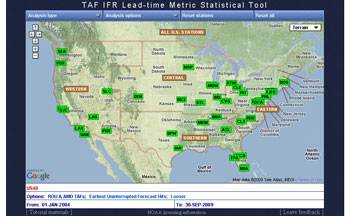Forecast Evaluation Tools
Missy Petty, Acting Chief
Brian Etherton, Acting Deputy Chief
Forecast Verification Section staff has been developing forecast evaluation tools since the early 90's.
Publications - http://esrl.noaa.gov/fiqas/publications.html
The Network-Enabled Verification Service (NEVS - http://esrl.noaa.gov/nevs/) is a net-enabled forecast verification service that uses advanced meteorological verification techniques that are integrated with key operational aviation decisions for evaluating meteorological forecast quality, accuracy, timeliness, and reliability. The NEVS infrastructure effectively distributes the automated verification information to NextGen users (human and automated) through network-enabled technologies. It also employs a relational database management system for integrating, storing, and accessing the verification information. NEVS is an automated service that acquires and processes forecast and observation data as they becomes available and provides machine to machine communication directly to automated decision support tools as well as to humans through a user-directed web-based graphical user interface.
Publications and posters - http://esrl.noaa.gov/fiqas/publications.html
The Real Time Verification System (RTVS; http://rtvs.noaa.gov/) is a tool that provides a historical record of aviation forecast performance and is used operationally by aviation managers, forecasters, and operational decision makers. The RTVS was the first system of its kind. It was built by using a relational database management system (DBMS) for organizing and accumulating verification. Users request the information from the DBMS through an interactive web-based graphical user interface allowing on-the-fly data analysis and graphing of user-specific verification results. Other tools that use the RTVS infrastructure include the TAF Evaluation Tool, the NCEP Model Forecast Evaluation Tool, and the Precipitation Forecast Evaluation Tool.
The TAF Lead-Time Metric Statistical Tool (http://rtvs-taf.noaa.gov/) is a new tool that has been developed for assessing skill in forecasting the onset of Instrument Flight Rules events (IFR events). The method utilized by the TAF Lead-Time Metric Statistical Tool compares the onset from observed IFR events (via METARs) with the onset from NWS-issued Terminal Aerodrome Forecasts (TAFs). This tool is being released in September 2009 for use by NWS forecasters and managers.
The NCEP Model Verification Tool (http://rtvs.noaa.gov/NCEP_verif/) is a tool that was developed to provide diagnostic feedback to NCEP model developers and model users.




